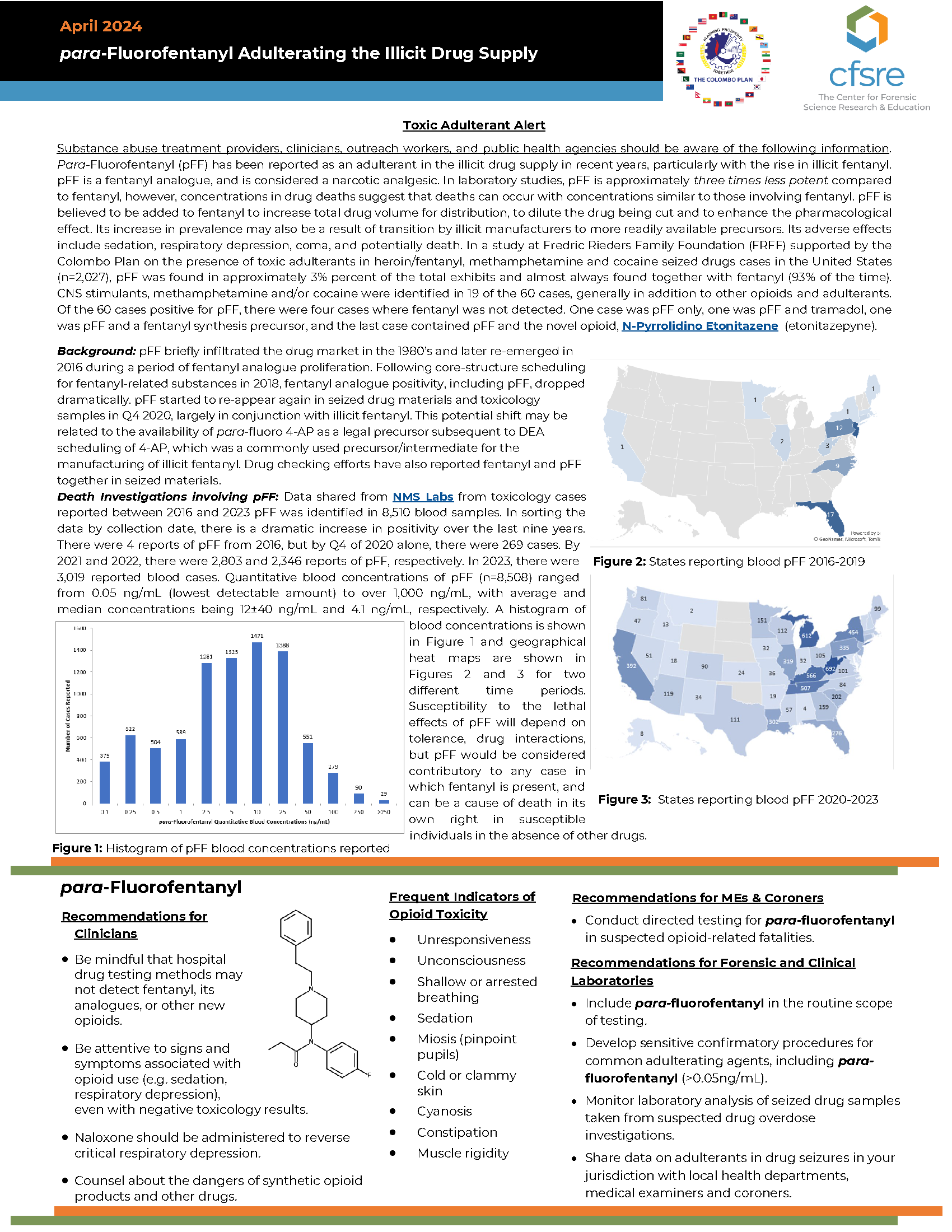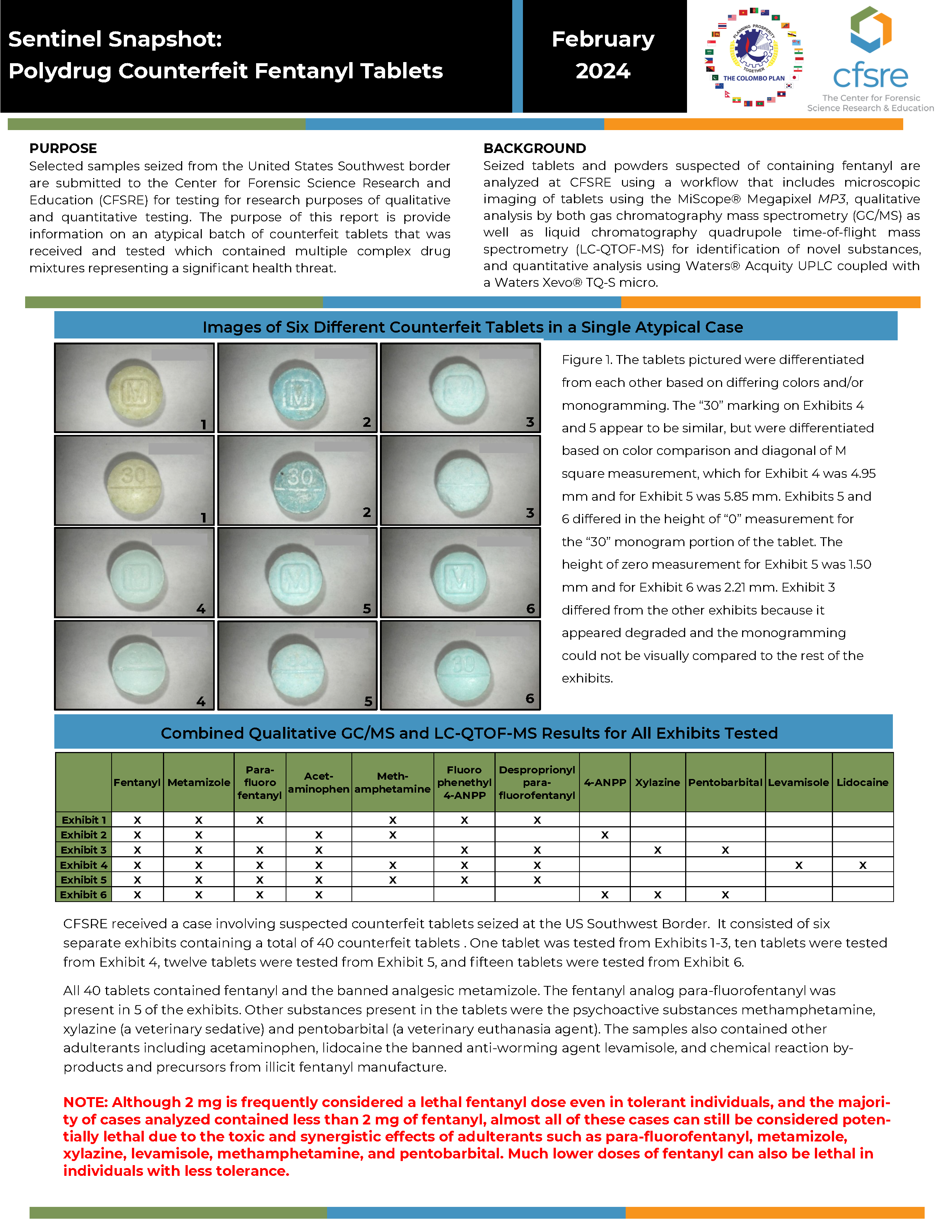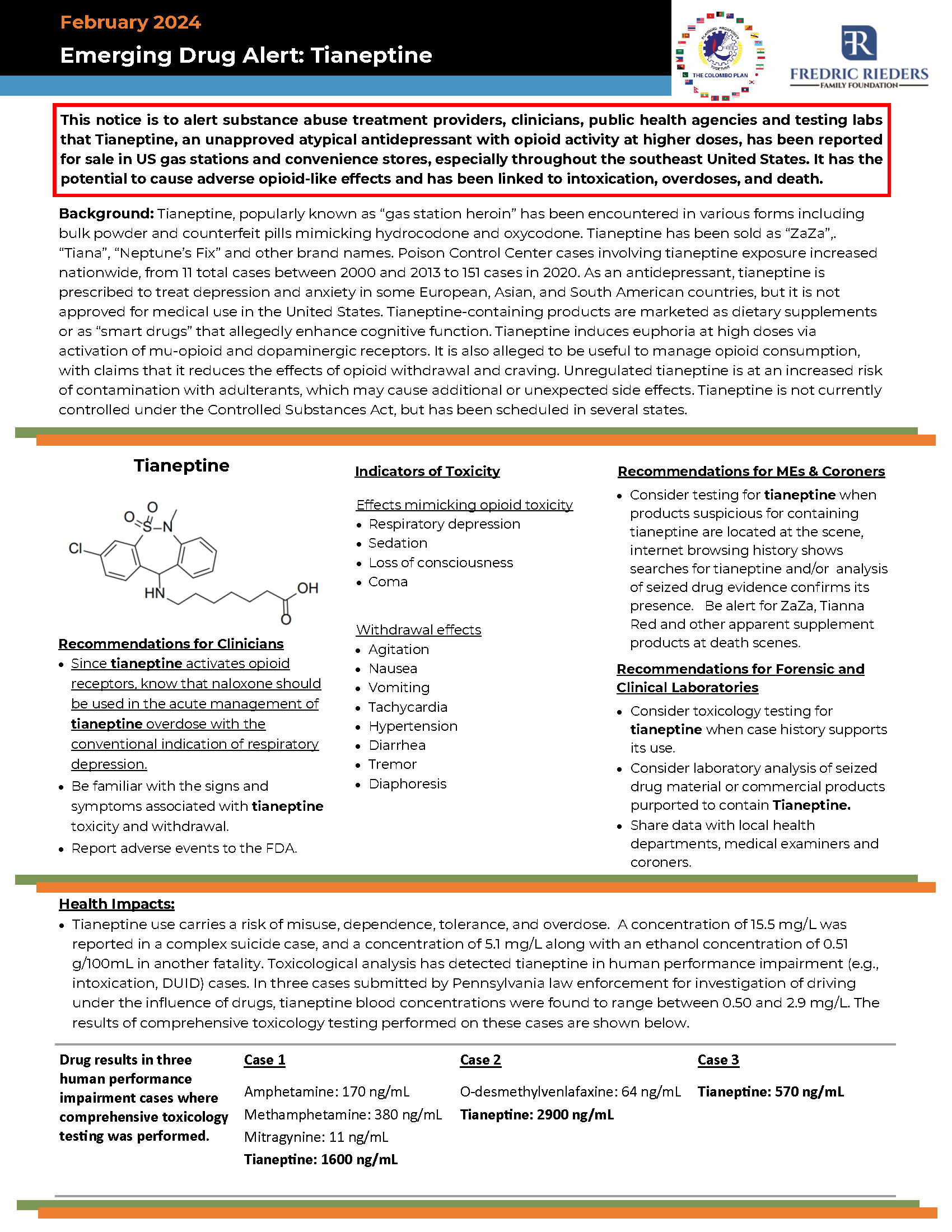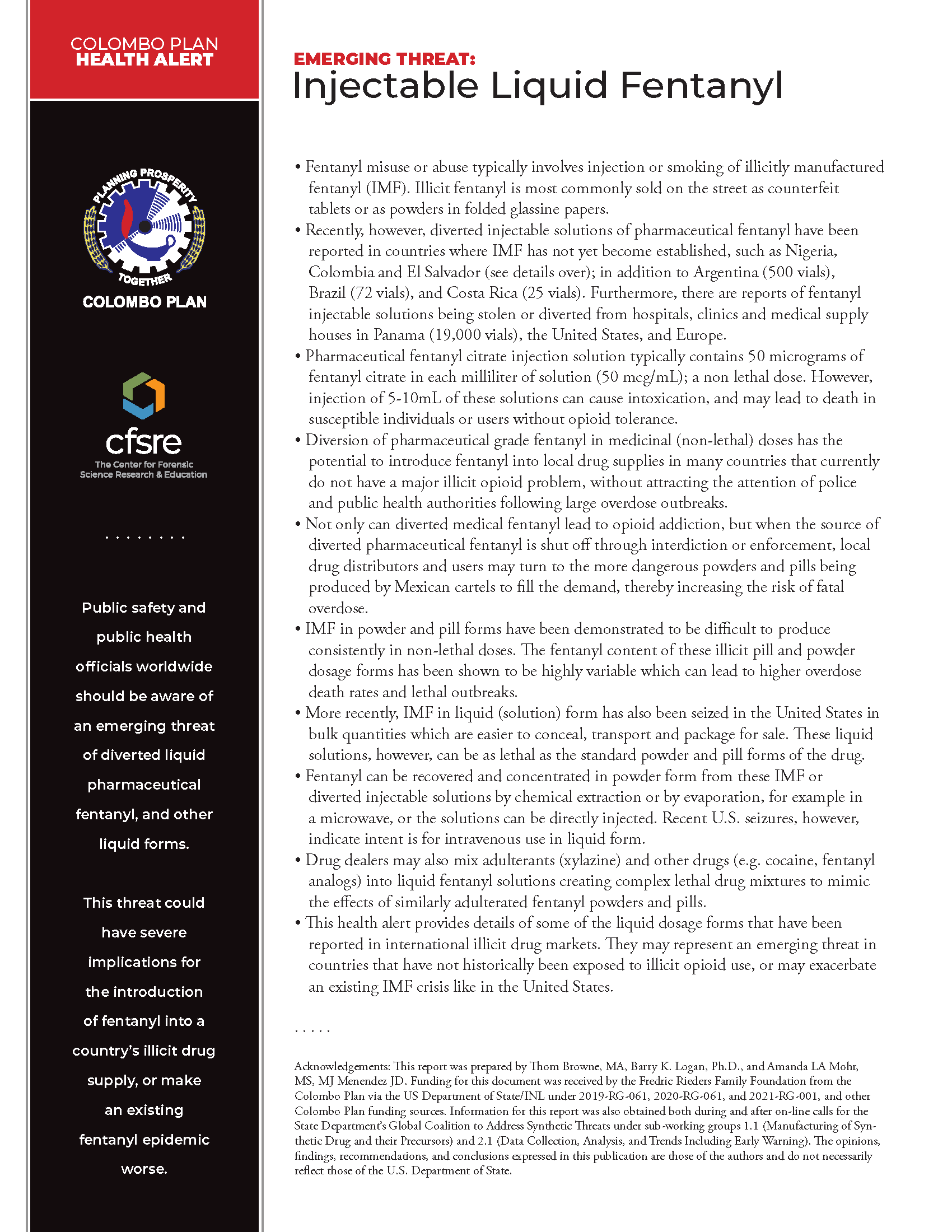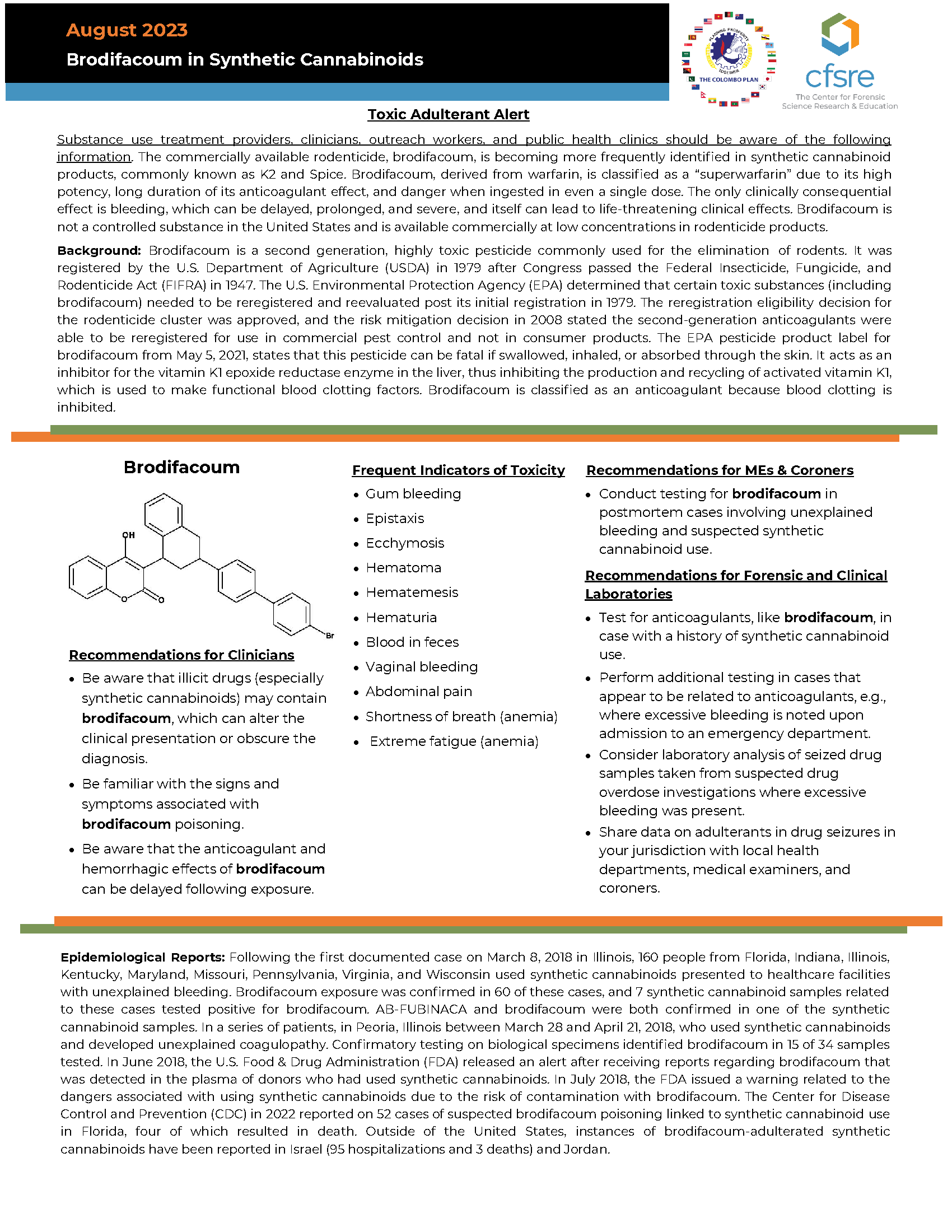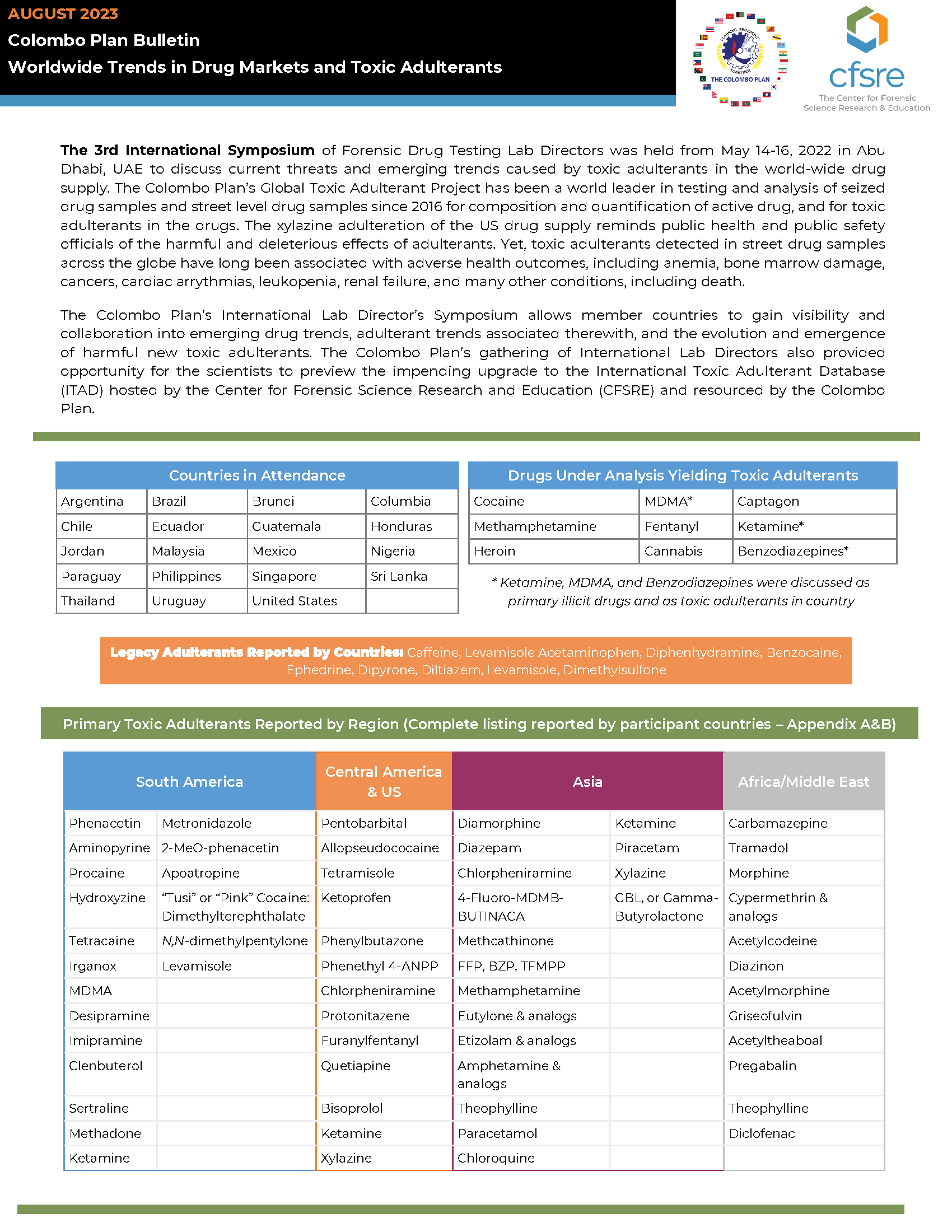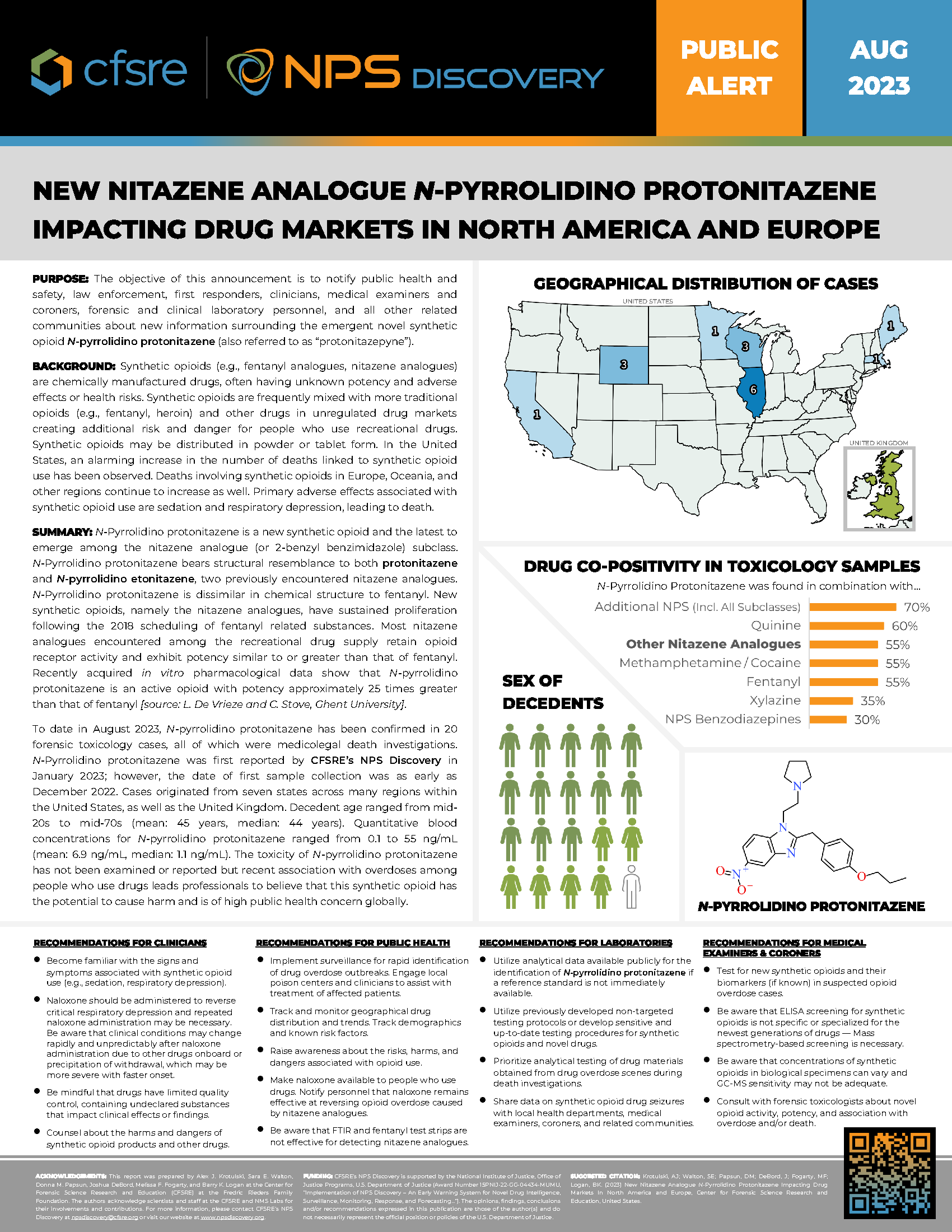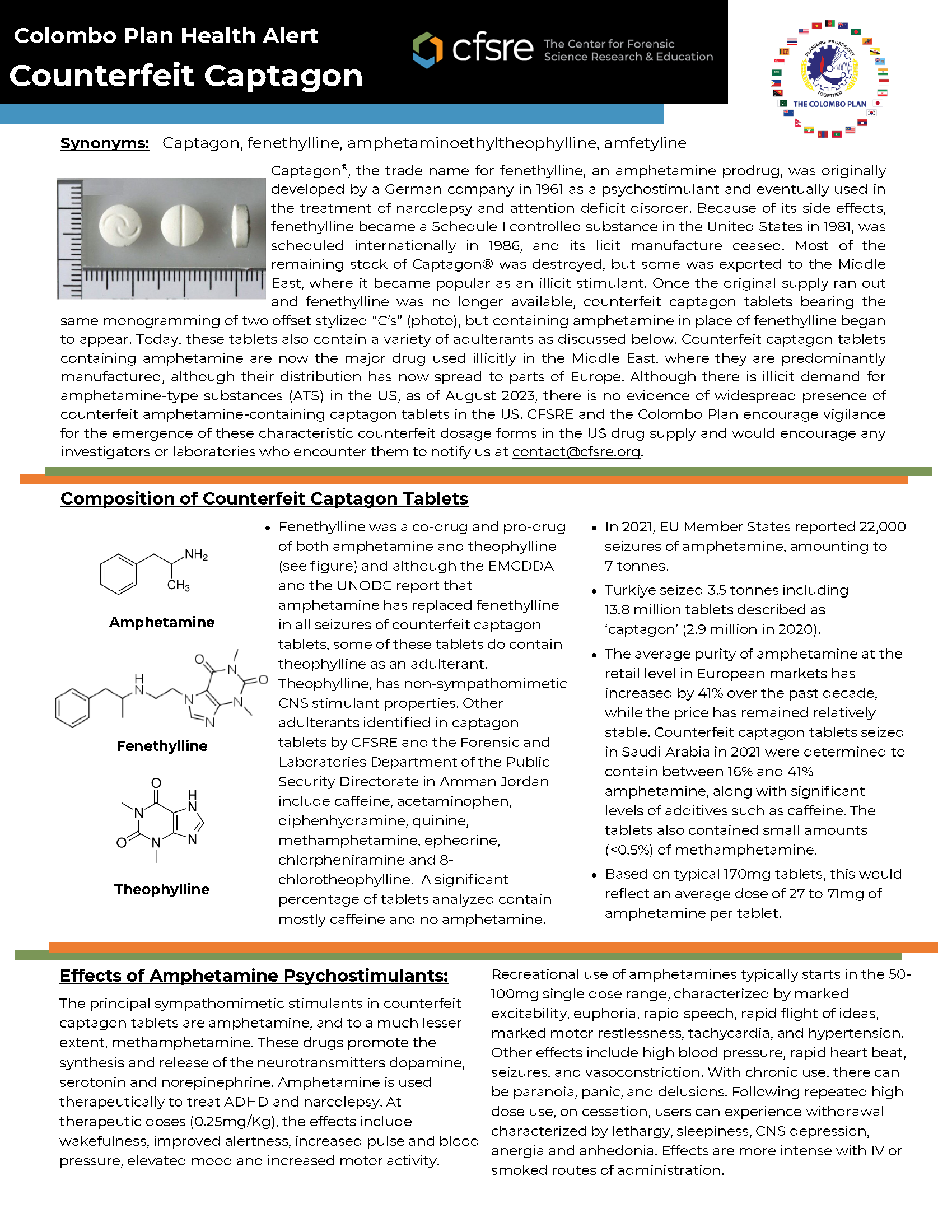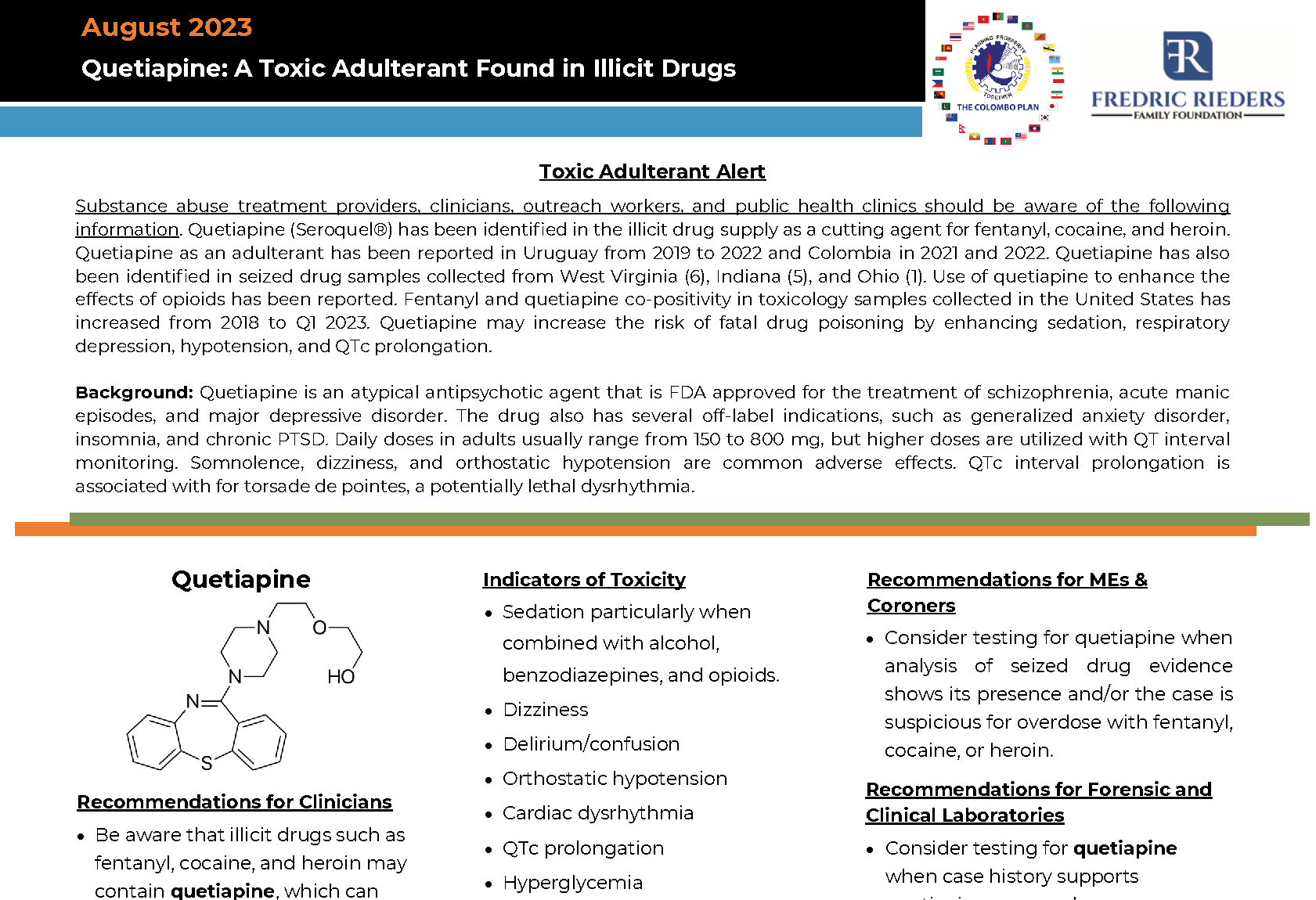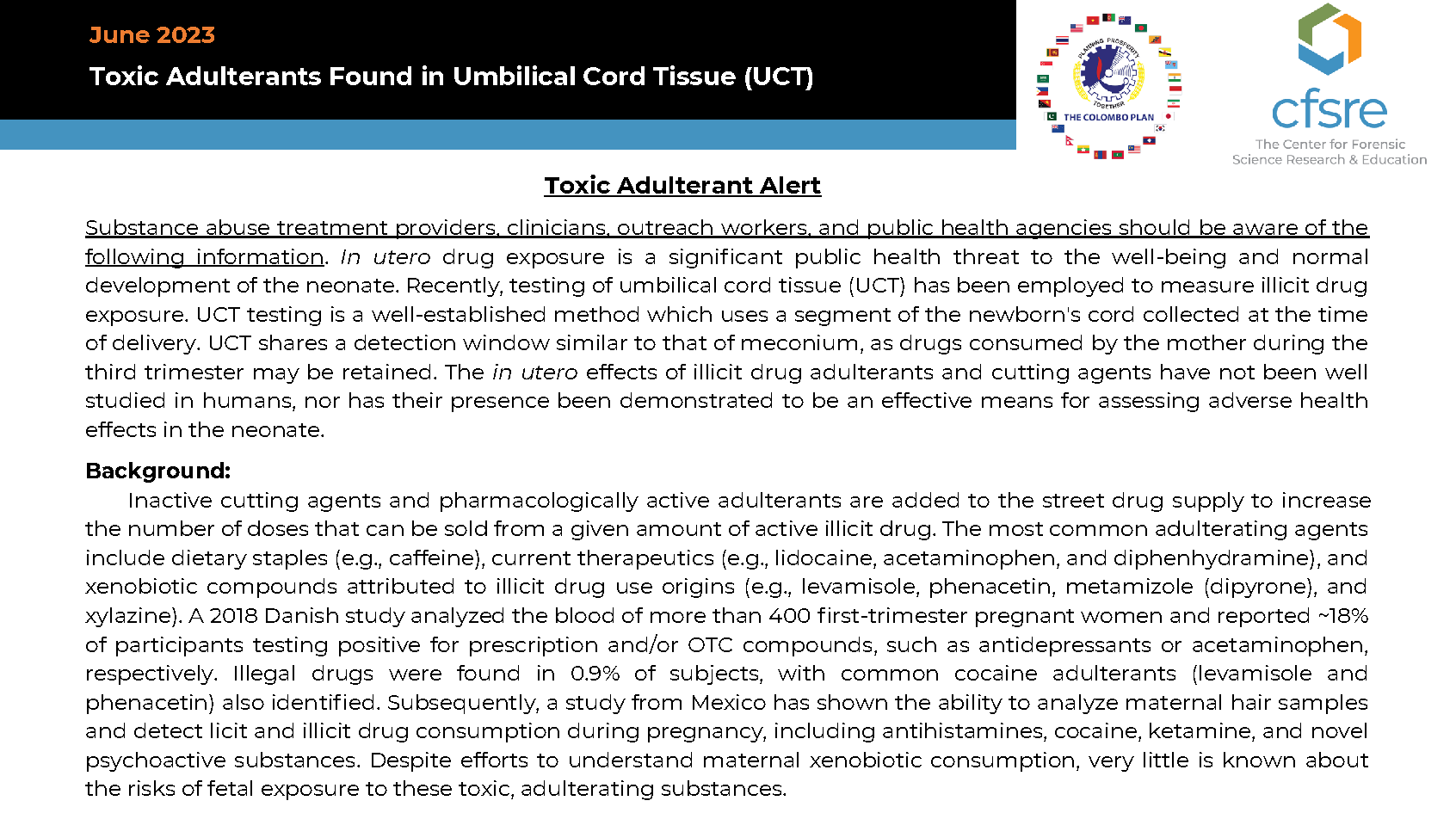Public Alerts
para-Fluorofentanyl (pFF) has been reported as an adulterant in the illicit drug supply in recent years, particularly with the rise in illicit fentanyl. pFF is a fentanyl analogue, and is considered a narcotic analgesic. In laboratory studies, pFF is approximately three times less potent compared to fentanyl, however, concentrations in drug deaths suggest that deaths can occur with concentrations similar to those involving fentanyl. pFF is believed to be added to fentanyl to increase total drug volume for distribution, to dilute the drug being cut and to enhance the pharmacological effect. Its increase in prevalence may also be a result of transition by illicit manufacturers to more readily available precursors. Its adverse effects include sedation, respiratory depression, coma, and potentially death. In a study at the Fredric Rieders Family Foundation (FRFF) supported by the Colombo Plan on the presence of toxic adulterants in heroin/fentanyl, methamphetamine and cocaine seized drugs case in the United States (n=2,027), pFF was found in approximately 3% percent of the total exhibits and almost always found together with fentanyl (93% of the time). CNS stimulants, methamphetamine and/or cocaine were identified in 19 of the 60 cases, generally in addition to other opioids and adulterants. Of the 60 cases positive for pFF, there were four cases where fentanyl was not detected. One case was pFF only, one was pFF and tramadol, one was pFF and a fentanyl synthesis precursor, and the last case contained pFF and the novel opioid, N-Pyrrolidino Etonitazene (etonitazepyne).
Selected samples seized from the United States Southwest border are submitted to the Center for Forensic Science Research and Education (CFSRE) for testing for research purposes of qualitative and quantitative testing. The purpose of this report is provide information on an atypical batch of counterfeit tablets that was received and tested which contained multiple complex drug mixtures representing a significant health threat.
Seized tablets and powders suspected of containing fentanyl are analyzed at CFSRE using a workflow that includes microscopic imaging of tablets using the MiScope® Megapixel MP3, qualitative analysis by both gas chromatography mass spectrometry (GC/MS) as well as liquid chromatography quadrupole time-of-flight mass spectrometry (LC-QTOF-MS) for identification of novel substances, and quantitative analysis using Waters® Acquity UPLC coupled with a Waters Xevo® TQ-S micro.
DOWNLOAD THE ALERT
Tianeptine, popularly known as “gas station heroin” has been encountered in various forms including bulk powder and counterfeit pills mimicking hydrocodone and oxycodone. Tianeptine has been sold as “ZaZa”,. “Tiana”, “Neptune’s Fix” and other brand names. Poison Control Center cases involving tianeptine exposure increased nationwide, from 11 total cases between 2000 and 2013 to 151 cases in 2020. As an antidepressant, tianeptine is prescribed to treat depression and anxiety in some European, Asian, and South American countries, but it is not approved for medical use in the United States. Tianeptine-containing products are marketed as dietary supplements or as “smart drugs” that allegedly enhance cognitive function. Tianeptine induces euphoria at high doses via activation of mu-opioid and dopaminergic receptors. It is also alleged to be useful to manage opioid consumption, with claims that it reduces the effects of opioid withdrawal and craving. Unregulated tianeptine is at an increased risk of contamination with adulterants, which may cause additional or unexpected side effects. Tianeptine is not currently controlled under the Controlled Substances Act, but has been scheduled in several states.
DOWNLOAD THE ALERT- Fentanyl misuse or abuse typically involves injection or smoking of illicitly manufactured fentanyl (IMF). Illicit fentanyl is most commonly sold on the street as counterfeit tablets or as powders in folded glassine papers.
- Recently, however, diverted injectable solutions of pharmaceutical fentanyl have been reported in countries where IMF has not yet become established, such as Nigeria, Colombia and El Salvador (see details over); in addition to Argentina (500 vials), Brazil (72 vials), and Costa Rica (25 vials). Furthermore, there are reports of fentanyl injectable solutions being stolen or diverted from hospitals, clinics and medical supply houses in Panama (19,000 vials), the United States, and Europe.
Medetomidine (Domitor®) has recently been identified as an adulterant in illicit drug material. Since July 2022, it has been detected in several seized drug samples across the state of Maryland, and in drug paraphernalia and illicit drug seizures submitted to public health and law enforcement agencies. It was most frequently observed in samples containing fentanyl and xylazine, though medetomidine has also been identified together with fentanyl analogs, heroin, and cocaine. Medetomidine has also been detected in overdoses in St. Louis and clandestine laboratory seizures in Ohio, Florida, and Canada. It is typically a minor component in the these samples, but is of toxicological concern.
DOWNLOAD THE ALERT
The 3rd International Symposium of Forensic Drug Testing Lab Directors was held from May 14-16, 2022 in Abu Dhabi, UAE to discuss current threats and emerging trends caused by toxic adulterants in the world-wide drug supply. The Colombo Plan’s Global Toxic Adulterant Project has been a world leader in testing and analysis of seized drug samples and street level drug samples since 2016 for composition and quantification of active drug, and for toxic adulterants in the drugs. The xylazine adulteration of the US drug supply reminds public health and public safety officials of the harmful and deleterious effects of adulterants. Yet, toxic adulterants detected in street drug samples across the globe have long been associated with adverse health outcomes, including anemia, bone marrow damage, cancers, cardiac arrythmias, leukopenia, renal failure, and many other conditions, including death.
The Colombo Plan’s International Lab Director’s Symposium allows member countries to gain visibility and collaboration into emerging drug trends, adulterant trends associated therewith, and the evolution and emergence of harmful new toxic adulterants. The Colombo Plan’s gathering of International Lab Directors also provided opportunity for the scientists to preview the impending upgrade to the International Toxic Adulterant Database (ITAD) hosted by the Center for Forensic Science Research and Education (CFSRE) and resourced by the Colombo Plan.
DOWNLOAD THE ALERT
New Nitazene Analogue N-Pyrrolidino Protonitazene Impacting Drug Markets In North America and Europe
N-Pyrrolidino protonitazene is a new synthetic opioid and the latest to emerge among the nitazene analogue (or 2-benzyl benzimidazole) subclass. N-Pyrrolidino protonitazene bears structural resemblance to both protonitazene and N-pyrrolidino etonitazene, two previously encountered nitazene analogues. N-Pyrrolidino protonitazene is dissimilar in chemical structure to fentanyl. New synthetic opioids, namely the nitazene analogues, have sustained proliferation following the 2018 scheduling of fentanyl related substances. Most nitazene analogues encountered among the recreational drug supply retain opioid receptor activity and exhibit potency similar to or greater than that of fentanyl. Recently acquired in vitro pharmacological data show that N-pyrrolidino protonitazene is an active opioid with potency approximately 25 times greater than that of fentanyl [source: L. De Vrieze and C. Stove, Ghent University].
To date in August 2023, N-pyrrolidino protonitazene has been confirmed in 20 forensic toxicology cases, all of which were medicolegal death investigations. N-Pyrrolidino protonitazene was first reported by CFSRE’s NPS Discovery in January 2023; however, the date of first sample collection was as early as December 2022. Cases originated from seven states across many regions within the United States, as well as the United Kingdom. Decedent age ranged from mid-20s to mid-70s (mean: 45 years, median: 44 years). Quantitative blood concentrations for N-pyrrolidino protonitazene ranged from 0.1 to 55 ng/mL (mean: 6.9 ng/mL, median: 1.1 ng/mL). The toxicity of N-pyrrolidino protonitazene has not been examined or reported but recent association with overdoses among people who use drugs leads professionals to believe that this synthetic opioid has the potential to cause harm and is of high public health concern globally.
Captagon®, the trade name for fenethylline, an amphetamine prodrug, was originally developed by a German company in 1961 as a psychostimulant and eventually used in the treatment of narcolepsy and attention deficit disorder. Because of its side effects, fenethylline became a Schedule I controlled substance in the United States in 1981, was scheduled internationally in 1986, and its licit manufacture ceased. Most of the remaining stock of Captagon® was destroyed, but some was exported to the Middle East, where it became popular as an illicit stimulant. Once the original supply ran out and fenethylline was no longer available, counterfeit captagon tablets bearing the same monogramming of two offset stylized “C’s” (photo), but containing amphetamine in place of fenethylline began to appear. Today, these tablets also contain a variety of adulterants as discussed below. Counterfeit captagon tablets containing amphetamine are now the major drug used illicitly in the Middle East, where they are predominantly manufactured, although their distribution has now spread to parts of Europe. Although there is illicit demand for amphetamine-type substances (ATS) in the US, as of August 2023, there is no evidence of widespread presence of counterfeit amphetamine-containing captagon tablets in the US. CFSRE and the Colombo Plan encourage vigilance for the emergence of these characteristic counterfeit dosage forms in the US drug supply and would encourage any investigators or laboratories who encounter them to notify us at This email address is being protected from spambots. You need JavaScript enabled to view it..
DOWNLOAD THE ALERT
Quetiapine is an atypical antipsychotic agent that is FDA approved for the treatment of schizophrenia, acute manic episodes, and major depressive disorder. The drug also has several off-label indications, such as generalized anxiety disorder, insomnia, and chronic PTSD. Daily doses in adults usually range from 150 to 800 mg, but higher doses are utilized with QT interval monitoring. Somnolence, dizziness, and orthostatic hypotension are common adverse effects. QTc interval prolongation is associated with torsade de pointes, a potentially lethal dysrhythmia.
DOWNLOAD THE ALERT
In utero drug exposure is a significant public health threat to the well-being and normal development of the neonate. Recently, testing of umbilical cord tissue (UCT) has been employed to measure illicit drug exposure. UCT testing is a well-established method which uses a segment of the newborn's cord collected at the time of delivery. UCT shares a detection window similar to that of meconium, as drugs consumed by the mother during the third trimester may be retained. The in utero effects of illicit drug adulterants and cutting agents have not been well studied in humans, nor has their presence been demonstrated to be an effective means for assessing adverse health effects in the neonate.
DOWNLOAD THE ALERT



